Conceptual Analysis on Severe Plastic Deformation Processes of Shape Memory Alloys: Mechanical Properties and Microstructure Characterization
Abstract
:1. Introduction
2. Influence of SPD Processing on the Shape Memory Effect
3. Effect of Different SPD Techniques on the Behavior of SMAs
3.1. Constrained Groove Pressing (CGP)
3.2. Equal-Channel Angular Pressing/Extrusion (ECAP/E)
3.3. High-Speed High-Pressure Torsion (HSHPT)
3.4. Local Canning Compression (LCC)
3.5. Accumulative Roll-Bonding (ARB)
4. Conclusions and Future Remarks
Author Contributions
Funding
Institutional Review Board Statement
Informed Consent Statement
Data Availability Statement
Conflicts of Interest
References
- Ebrahimi, M.; Wang, Q.; Attarilar, S. A comprehensive review of magnesium-based alloys and composites processed by cyclic extrusion compression and the related techniques. Prog. Mater. Sci. 2023, 131, 101016. [Google Scholar] [CrossRef]
- Langdon, T.G. Twenty-five years of ultrafine-grained materials: Achieving exceptional properties through grain refinement. Acta Mater. 2013, 61, 7035–7059. [Google Scholar] [CrossRef]
- Edalati, K.; Horita, Z. A review on high-pressure torsion (HPT) from 1935 to 1988. Mater. Sci. Eng. A 2016, 652, 325–352. [Google Scholar] [CrossRef]
- Valiev, R.Z.; Langdon, T.G. Principles of equal-channel angular pressing as a processing tool for grain refinement. Prog. Mater. Sci. 2006, 51, 881–981. [Google Scholar] [CrossRef]
- Djavanroodi, F.; Omranpour, B.; Ebrahimi, M.; Sedighi, M. Designing of ECAP parameters based on strain distribution uniformity. Prog. Nat. Sci. Mater. Int. 2012, 22, 452–460. [Google Scholar] [CrossRef] [Green Version]
- Attarilar, S.; Salehi, M.T.; Djavanroodi, F. Microhardness evolution of pure titanium deformed by equal channel angular extrusion. Metall. Res. Technol. 2019, 116, 1–10. [Google Scholar] [CrossRef] [Green Version]
- Ebrahimi, M.; Djavanroodi, F.; Tiji, S.; Gholipour, H.; Gode, C. Experimental Investigation of the Equal Channel Forward Extrusion Process. Metals 2015, 5, 471–483. [Google Scholar] [CrossRef] [Green Version]
- Wu, J.; Ebrahimi, M.; Attarilar, S.; Gode, C.; Zadshakoyan, M. Cyclic Extrusion Compression Process for Achieving Ultrafine-Grained 5052 Aluminum Alloy with Eminent Strength and Wear Resistance. Metals 2022, 12, 1627. [Google Scholar] [CrossRef]
- Ebrahimi, M.; Wang, Q. Accumulative roll-bonding of aluminum alloys and composites: An overview of properties and performance. J. Mater. Res. Technol. 2022, 19, 4381–4403. [Google Scholar] [CrossRef]
- Fan, R.; Attarilar, S.; Shamsborhan, M.; Ebrahimi, M.; Gode, C.; Özkavak, H.V. Enhancing mechanical properties and corrosion performance of AA6063 aluminum alloys through constrained groove pressing technique. Trans. Nonferrous Met. Soc. China 2020, 30, 1790–1802. [Google Scholar] [CrossRef]
- Djavanroodi, F.; Ebrahimi, M.; Nayfeh, J.F. Tribological and mechanical investigation of multi-directional forged nickel. Sci. Rep. 2019, 9, 241. [Google Scholar] [CrossRef] [PubMed] [Green Version]
- Ebrahimi, M.; Par, M.A. Twenty-year uninterrupted endeavor of friction stir processing by focusing on copper and its alloys. J. Alloys Compd. 2019, 781, 1074–1090. [Google Scholar] [CrossRef]
- Ebrahimi, M.; Shamsborhan, M. Monotonic and dynamic mechanical properties of PTCAE aluminum. J. Alloys Compd. 2017, 705, 28–37. [Google Scholar] [CrossRef]
- Ebrahimi, M. Fatigue Behaviors of Materials Processed by Planar Twist Extrusion. Metall. Mater. Trans. A 2017, 48, 6126–6134. [Google Scholar] [CrossRef]
- Mohd, J.; Leary, M.; Subic, A.; Gibson, M.A. A review of shape memory alloy research, applications and opportunities. Mater. Des. 2014, 56, 1078–1113. [Google Scholar] [CrossRef]
- Liang, L.; Xu, M.; Chen, Y.; Zhang, T.; Tong, W.; Liu, H.; Wang, H.; Li, H. Effect of welding thermal treatment on the microstructure and mechanical properties of nickel-based superalloy fabricated by selective laser melting. Mater. Sci. Eng. A 2021, 819, 141507. [Google Scholar] [CrossRef]
- Miyazaki, S.; Otsuka, K. Development of Shape Memory Alloys. ISIJ Int. 1989, 29, 353–377. [Google Scholar] [CrossRef]
- Ölander, A. An electrochemical investigation of solid cadmium-gold alloys. J. Am. Chem. Soc. 1932, 54, 3819–3833. [Google Scholar] [CrossRef]
- Buehler, W.J.; Gilfrich, J.V.; Wiley, R.C. Effect of Low-Temperature Phase Changes on the Mechanical Properties of Alloys near Composition TiNi. J. Appl. Phys. 1963, 34, 1475. [Google Scholar] [CrossRef]
- Furuya, Y.; Shimada, H. Shape memory actuators for robotic applications. Mater. Des. 1991, 12, 21–28. [Google Scholar] [CrossRef]
- Babacan, N.; Atli, K.C.; Turkbas, O.S.; Karaman, I.; Kockar, B. The effect of dynamic aging on the cyclic stability of Cu73Al16Mn11 shape memory alloy. Mater. Sci. Eng. A 2017, 701, 352–358. [Google Scholar] [CrossRef]
- Humbeeck, J. Van Non-medical applications of shape memory alloys. Mater. Sci. Eng. A 1999, 273–275, 134–148. [Google Scholar] [CrossRef]
- Hartl, D.J.; Lagoudas, D.C. Aerospace applications of shape memory alloys. Proc. Inst. Mech. Eng. Part G J. Aerosp. Eng. 2007, 221, 535–552. [Google Scholar] [CrossRef] [Green Version]
- Bil, C.; Massey, K.; Abdullah, E.J. Wing morphing control with shape memory alloy actuators. J. Intell. Mater. Syst. Struct. 2013, 24, 879–898. [Google Scholar] [CrossRef]
- Jani, J.M.; Leary, M.; Subic, A. Shape memory alloys in automotive applications. Appl. Mech. Mater. 2014, 663, 248–253. [Google Scholar] [CrossRef]
- Qi, Y.; Lapovok, R.; Estrin, Y. Microstructure and electrical conductivity of aluminium/steel bimetallic rods processed by severe plastic deformation. J. Mater. Sci. 2016, 51, 6860–6875. [Google Scholar] [CrossRef]
- Zehetbauer, M.; Grössinger, R.; Krenn, H.; Krystian, M.; Pippan, R.; Rogl, P.; Waitz, T.; Würschum, R. Bulk nanostructured functional materials by severe plastic deformation. Adv. Eng. Mater. 2010, 12, 692–700. [Google Scholar] [CrossRef]
- Guillem-Martí, J.; Herranz-Díez, C.; Shaffer, J.E.; Gil, F.J.; Manero, J.M. Mechanical and microstructural characterization of new nickel-free low modulus β-type titanium wires during thermomechanical treatments. Mater. Sci. Eng. A 2015, 636, 507–515. [Google Scholar] [CrossRef] [Green Version]
- He, J.; Zhu, S.; Luo, C.; Niu, X.; Wang, Q. Size effect in fatigue modelling of defective materials: Application of the calibrated weakest-link theory. Int. J. Fatigue 2022, 165, 107213. [Google Scholar] [CrossRef]
- Xu, H.; He, T.; Zhong, N.; Zhao, B.; Liu, Z. Transient thermomechanical analysis of micro cylindrical asperity sliding contact of SnSbCu alloy. Tribol. Int. 2022, 167, 107362. [Google Scholar] [CrossRef]
- Sathish, S.; Mallik, U.S.; Raju, T.N. Microstructure and Shape Memory Effect of Cu-Zn-Ni Shape Memory Alloys. J. Miner. Mater. Charact. Eng. 2014, 2, 71–77. [Google Scholar] [CrossRef] [Green Version]
- Liu, J.L.; Huang, H.Y.; Xie, J.X. Superelastic anisotropy characteristics of columnar-grained Cu-Al-Mn shape memory alloys and its potential applications. Mater. Des. 2015, 85, 211–220. [Google Scholar] [CrossRef]
- Huang, W. On the selection of shape memory alloys for actuators. Mater. Des. 2002, 23, 11–19. [Google Scholar] [CrossRef]
- Bhardwaj, A.; Gupta, A.K.; Padisala, S.K.; Poluri, K. Characterization of mechanical and microstructural properties of constrained groove pressed nitinol shape memory alloy for biomedical applications. Mater. Sci. Eng. C 2019, 102, 730–742. [Google Scholar] [CrossRef]
- Sun, L.; Huang, W.M.; Ding, Z.; Zhao, Y.; Wang, C.C.; Purnawali, H.; Tang, C. Stimulus-responsive shape memory materials: A review. Mater. Des. 2012, 33, 577–640. [Google Scholar] [CrossRef]
- Sakon, T.; Nagashio, H.; Sasaki, K.; Susuga, S.; Numakura, D.; Abe, M.; Endo, K.; Yamashita, S.; Nojiri, H.; Kanomata, T. Thermal strain and magnetization of the ferromagnetic shape memory alloy Ni52Mn25Ga23 in a magnetic field. J. Phys. Chem. Solids 2013, 74, 158–165. [Google Scholar] [CrossRef]
- Li, Y.; Jiang, C.; Liang, T.; Ma, Y.; Xu, H. Martensitic transformation and magnetization of Ni–Fe–Ga ferromagnetic shape memory alloys. Scr. Mater. 2003, 48, 1255–1258. [Google Scholar] [CrossRef]
- Namvari, M.; Laitinen, V.; Sozinov, A.; Saren, A.; Ullakko, K. Effects of 1 at.% additions of Co, Fe, Cu, and Cr on the properties of Ni-Mn-Ga-based magnetic shape memory alloys. Scr. Mater. 2023, 224, 115116. [Google Scholar] [CrossRef]
- Dan, N.H.; Hau, K.X.; Yen, N.H.; Thi Thanh, P.; Ngoc, N.H.; Anh, T.V.; Nguyet Nga, N.T.; Anh, D.T.K. Structure and magnetic properties of Ni50−xCoxMn50−yAly (x = 5–9, y = 18–19) shape memory alloy ribbons. J. Alloys Compd. 2022, 916, 165470. [Google Scholar] [CrossRef]
- Amako, Y.; Tanaka, S.; Nakashima, M.; Eto, T.; Adachi, Y.; Kanomata, T. 119Sn Mössbauer and magnetization studies of the Heusler alloy Ni2Mn1.48Sn0.52. J. Phys. Chem. Solids 2023, 172, 111101. [Google Scholar] [CrossRef]
- Heczko, O.; Straka, L. Compositional dependence of structure, magnetization and magnetic anisotropy in Ni–Mn–Ga magnetic shape memory alloys. J. Magn. Magn. Mater. 2004, 272–276, 2045–2046. [Google Scholar] [CrossRef]
- Wang, S.; Yang, R.; Lu, G.; Yi, L.; Liu, M.; Xu, Y.; Pan, L. Atomic occupation and role of Cr atoms in Cr-doped Ni43Co7Mn39Sn11 magnetic shape memory alloys. J. Alloys Compd. 2022, 929, 167315. [Google Scholar] [CrossRef]
- Yang, H.; An, K.; Nie, Z.H.; Wang, Y.D.; Tang, B.; Peng, T. The anomalous staircase-like magnetization behavior and giant magnetocaloric effect in a Fe–Mn-Ga magnetic shape memory alloy. Intermetallics 2020, 127, 106975. [Google Scholar] [CrossRef]
- Gao, W.; Yi, X.; Sun, B.; Fu, Y.; Meng, X. Low-cost (ZrCu)50-xTax high temperature shape memory alloys showing excellent shape memory effect. Prog. Nat. Sci. Mater. Int. 2022, 32, 369–374. [Google Scholar] [CrossRef]
- Montecinos, S.; Cuniberti, A.; Sepúlveda, A. Grain size and pseudoelastic behaviour of a Cu–Al–Be alloy. Mater. Charact. 2008, 59, 117–123. [Google Scholar] [CrossRef]
- Casciati, F.; Faravelli, L. Experimental characterisation of a Cu-based shape memory alloy toward its exploitation in passive control devices. J. Phys. IV 2004, 115, 299–306. [Google Scholar] [CrossRef]
- Torra, V.; Isalgue, A.; Lovey, F.C.; Martorell, F.; Molina, F.J.; Sade, M.; Tachoire, H. Shape memory alloys: From the physical properties of metastable phase transitions to dampers for civil engineering applications. J. Phys. IV 2004, 113, 85–90. [Google Scholar] [CrossRef] [Green Version]
- Figueroa, C.G.; Garcia-Castillo, F.N.; Jacobo, V.H.; Cortés-Pérez, J.; Schouwenaars, R. Microstructural and superficial modification in a Cu-Al-Be shape memory alloy due to superficial severe plastic deformation under sliding wear conditions. IOP Conf. Ser. Mater. Sci. Eng. 2017, 194, 012011. [Google Scholar] [CrossRef] [Green Version]
- Zhang, Y.; He, X.; Xu, K.; Kang, Y.; Sun, H.; Liu, H.; Cao, Y.; Wei, S.; Li, Z.; Jing, C. Structural ordering, magnetic and electrical transport properties in Ni60-Fe13+Ga27 Heusler alloys. J. Alloys Compd. 2023, 936, 168242. [Google Scholar] [CrossRef]
- Nikolaev, V.I.; Stepanov, S.I.; Yakushev, P.N.; Krymov, V.M.; Kustov, S.B. Burst-like shape recovery and caloric effects in Ni–Fe–Ga–Co single crystalline shape memory alloys. Intermetallics 2020, 119, 106709. [Google Scholar] [CrossRef]
- Zhang, X.; Chen, H.; Li, S.; Niu, Y.; Yin, T.; Song, C.; Lang, R.; Cong, D.; Li, S.; Wang, Y.-D. Enhanced cyclability of superelasticity and elastocaloric effect in Cu and B co-doped Co-Ni-Ga shape memory alloys. J. Alloys Compd. 2022, 918, 165633. [Google Scholar] [CrossRef]
- Mendonça, A.A.; Ghivelder, L.; Bernardo, P.L.; Cohen, L.F.; Gomes, A.M. Low hysteretic magnetostructural transformation in Cr-doped Ni-Mn-Ga Heusler alloy. J. Alloys Compd. 2023, 938, 168444. [Google Scholar] [CrossRef]
- Tavares, S.; Yang, K.; Meyers, M.A. Heusler alloys: Past, properties, new alloys, and prospects. Prog. Mater. Sci. 2023, 132, 101017. [Google Scholar] [CrossRef]
- Cao, P.; Tian, F.; Li, W.; Vitos, L.; Wang, Y. Ideal superelasticity in Ni-based Heusler alloys. Acta Mater. 2021, 210, 116816. [Google Scholar] [CrossRef]
- Gurau, G.; Gurau, C.; Sampath, V.; Bujoreanu, L.G. Investigations of a nanostructured FeMnSi shape memory alloy produced via severe plastic deformation. Int. J. Miner. Metall. Mater. 2016, 23, 1315–1322. [Google Scholar] [CrossRef]
- Jiang, S.; Hu, L.; Zhang, Y.; Liang, Y. Nanocrystallization and amorphization of NiTi shape memory alloy under severe plastic deformation based on local canning compression. J. Non-Cryst. Solids 2013, 367, 23–29. [Google Scholar] [CrossRef]
- Sun, D.; Jiang, S.; Zhang, Y.; Yan, B.; Yu, J. Influence of annealing on incomplete detwinning and deformation twinning in equiatomic NiTi shape memory alloy undergoing severe plastic deformation. J. Alloys Compd. 2021, 871, 159550. [Google Scholar] [CrossRef]
- Hu, L.; Jiang, S.; Zhang, Y.; Zhao, Y.; Liu, S.; Zhao, C. Intermetallics Multiple plastic deformation mechanisms of NiTi shape memory alloy based on local canning compression at various temperatures. Intermetallics 2016, 70, 45–52. [Google Scholar] [CrossRef]
- Gunderov, D.V.; Kuranova, N.N.; Luk’Yanov, A.V.; Uksusnikov, A.N.; Prokof’Ev, E.A.; Yurchenko, L.I.; Valiev, R.Z.; Pushin, V.G. Application of severe plastic deformation by torsion to form amorphous and nanocrystalline states in large-size TiNi alloy sample. Phys. Met. Metallogr. 2009, 108, 131–138. [Google Scholar] [CrossRef]
- Jiang, S.Y.; Zhao, Y.N.; Zhang, Y.Q.; Tang, M.; Li, C.F. Equal channel angular extrusion of NiTi shape memory alloy tube. Trans. Nonferrous Met. Soc. China 2013, 23, 2021–2028. [Google Scholar] [CrossRef]
- Pushin, V.G.; Stolyarov, V.V.; Valiev, R.Z.; Lowe, T.C.; Zhu, Y.T. Nanostructured TiNi-based shape memory alloys processed by severe plastic deformation. Mater. Sci. Eng. A 2005, 411, 386–389. [Google Scholar] [CrossRef]
- Zhang, X.; Xia, B.; Song, J.; Chen, B.; Tian, X.; Hao, Y.; Xie, C. Effects of equal channel angular extrusion and aging treatment on R phase transformation behaviors and Ti3Ni4 precipitates of Ni-rich TiNi alloys. J. Alloys Compd. 2011, 509, 6296–6301. [Google Scholar] [CrossRef]
- Song, J.; Wang, L.M.; Zhang, X.N.; Sun, X.G.; Jiang, H.; Fan, Z.G.; Xie, C.Y.; Wu, M.H. Effects of second phases on mechanical properties and martensitic transformations of ECAPed TiNi and Ti-Mo based shape memory alloys. Trans. Nonferrous Met. Soc. China 2012, 22, 1839–1848. [Google Scholar] [CrossRef]
- Fan, Z.G.; Xie, C.Y. Shape Memory Behavior of Ti-50.9at%Ni Alloy after ECAE Processes. Mater. Sci. Forum 2007, 561–565, 2313–2316. [Google Scholar] [CrossRef]
- Zhang, X.; Song, J.; Huang, C.; Xia, B.; Chen, B.; Sun, X.; Xie, C. Microstructures evolution and phase transformation behaviors of Ni-rich TiNi shape memory alloys after equal channel angular extrusion. J. Alloys Compd. 2011, 509, 3006–3012. [Google Scholar] [CrossRef]
- Zhang, X.; Song, J.; Jiang, H.; Sun, X.; Xie, C. Effects of ECAE and aging on phase transformations and superelasticity of a Ni-rich TiNi SMA. Mater. Sci. Forum 2011, 682, 185–191. [Google Scholar] [CrossRef]
- Pushin, V.G.; Stolyarov, V.V.; Valiev, R.Z.; Kourov, N.I.; Kuranova, N.N.; Prokofiev, E.A.; Yurchenko, L.I. Features of structure and phase transformations in shape memory TiNi-based alloys after severe plastic deformation. Ann. Chim. Sci. Matériaux 2002, 27, 77–88. [Google Scholar] [CrossRef]
- Arockiakumar, R.; Park, J.K. Effect of α-precipitation on the superelastic behavior of Ti-40 wt.%Nb-0.3 wt.%O alloy processed by equal channel angular extrusion. Mater. Sci. Eng. A 2010, 527, 2709–2713. [Google Scholar] [CrossRef]
- Zhang, P.; Ma, A.; Lu, S.; Lin, P.; Jiang, J.; Ma, H.; Chu, C. Effect of equal channel angular pressing and heat treatment on the microstructure of Cu-Al-Be-B shape memory alloy. Mater. Lett. 2009, 63, 2676–2679. [Google Scholar] [CrossRef]
- Alizadeh, M.; Avazzadeh, M. Evaluation of Cu-26Zn-5Al shape memory alloy fabricated by accumulative roll bonding process. Mater. Sci. Eng. A 2019, 757, 88–94. [Google Scholar] [CrossRef]
- Alizadeh, M.; Dashtestaninejad, M.K. Fabrication of manganese-aluminum bronze as a shape memory alloy by accumulative roll bonding process. Mater. Des. 2016, 111, 263–270. [Google Scholar] [CrossRef] [Green Version]
- Ostovari Moghaddam, A.; Mazinani, A.; Ketabchi, M. Effect of Accumulative Roll Bonding and Equal Channel Angular Rolling on Microstructural and Mechanical Properties of Cu–Al–Mn Shape Memory Alloys. Trans. Indian Inst. Met. 2017, 70, 1901–1909. [Google Scholar] [CrossRef]
- Gurau, G.; Gurau, C.; Tolea, F.; Valeanu, M.; Sampath, V.; Bujoreanu, L.G. Effect of Severe Plastic Deformation on the Structure and Magnetic Behaviour of an Fe-Mn-Si Shape Memory Alloy. Adv. Mater. Res. 2017, 1143, 240–246. [Google Scholar] [CrossRef]
- Popescu, B.; Gurau, C.; Gurau, G.; Tolea, M.; Sofronie, M.; Tolea, F. Martensitic Transformation and Magnetic Properties of Ni57Fe18Ga25 Shape Memory Alloy Subjected to Severe Plastic Deformation. Trans. Indian Inst. Met. 2021, 74, 2491–2498. [Google Scholar] [CrossRef]
- Gurau, C.; Gurau, G.; Tolea, F.; Sampath, V. Structural evolution of the niti/nifega smart hybrid material during severe plastic deformation. Dig. J. Nanomater. Biostructures 2019, 14, 539–546. [Google Scholar]
- Waitz, T.; Antretter, T.; Fischer, F.D.; Karnthaler, H.P. Size effects on martensitic phase transformations in nanocrystalline NiTi shape memory alloys. Mater. Sci. Technol. 2008, 24, 934–940. [Google Scholar] [CrossRef]
- Sun, Q.P.; He, Y.J. A multiscale continuum model of the grain-size dependence of the stress hysteresis in shape memory alloy polycrystals. Int. J. Solids Struct. 2008, 45, 3868–3896. [Google Scholar] [CrossRef]
- Meng, Q.; Rong, Y.; Hsu, T.Y. Nucleation barrier for phase transformations in nanosized crystals. Phys. Rev. B 2002, 65, 174118. [Google Scholar] [CrossRef]
- Meng, Q.; Zhou, N.; Rong, Y.; Chen, S.; Hsu (Xu Zuyao), T.Y.; Zuyao, X. Size effect on the Fe nanocrystalline phase transformation. Acta Mater. 2002, 50, 4563–4570. [Google Scholar] [CrossRef]
- Lee, T.-J.; Kim, W.-J. Effect of Severe Plastic Deformation and Post-Deformation Heat Treatment on the Microstructure and Superelastic Properties of Ti-50.8 at.% Ni Alloy. Materials 2022, 15, 7822. [Google Scholar] [CrossRef]
- Satheesh Kumar, S.S.; Raghu, T. Structural and mechanical behaviour of severe plastically deformed high purity aluminium sheets processed by constrained groove pressing technique. Mater. Des. 2013, 57, 114–120. [Google Scholar] [CrossRef]
- Ebrahimi, M.; Attarilar, S.; Djavanroodi, F.; Gode, C.; Kim, H.S. Wear properties of brass samples subjected to constrained groove pressing process. Mater. Des. 2014, 63, 531–537. [Google Scholar] [CrossRef]
- Garudapalli, A.; Bhardwaj, A.; Oswal, K.; Mathur, D.; Gupta, A.K. Microstructural, Mechanical, and Superelastic Behavior of Thermo-Mechanically Processed Nitinol Alloy. Shape Mem. Superelasticity 2021, 7, 503–514. [Google Scholar] [CrossRef]
- Rohatgi, A.; Vecchio, K.S.; Gray, G.T. The influence of stacking fault energy on the mechanical behavior of Cu and Cu-Al alloys: Deformation twinning, work hardening, and dynamic recovery. Metall. Mater. Trans. A 2001, 32, 135–145. [Google Scholar] [CrossRef]
- Vercammen, S.; Blanpain, B.; De Cooman, B.C.; Wollants, P. Cold rolling behaviour of an austenitic Fe–30Mn–3Al–3Si TWIP-steel: The importance of deformation twinning. Acta Mater. 2004, 52, 2005–2012. [Google Scholar] [CrossRef]
- Xiao, G.H.; Tao, N.R.; Lu, K. Effects of strain, strain rate and temperature on deformation twinning in a Cu–Zn alloy. Scr. Mater. 2008, 59, 975–978. [Google Scholar] [CrossRef]
- Attarilar, S.; Djavanroodi, F.; Ebrahimi, M.; Al-Fadhalah, K.J.; Wang, L.; Mozafari, M. Hierarchical Microstructure Tailoring of Pure Titanium for Enhancing Cellular Response at Tissue-Implant Interface. J. Biomed. Nanotechnol. 2021, 17, 115–130. [Google Scholar] [CrossRef]
- Duerig, T.W.; Melton, K.N.; Stöckel, D. Engineering Aspects of Shape Memory Alloys; Butterworth-Heinemann: Oxford, UK, 2013. [Google Scholar]
- Shaeri, M.H.; Shaeri, M.; Ebrahimi, M.; Salehi, M.T.; Seyyedein, S.H. Effect of ECAP temperature on microstructure and mechanical properties of Al-Zn-Mg-Cu alloy. Prog. Nat. Sci. Mater. Int. 2016, 26, 182–191. [Google Scholar] [CrossRef] [Green Version]
- Ebrahimi, M.; Shaeri, M.H.; Gode, C.; Armoon, H.; Shamsborhan, M. The synergistic effect of dilute alloying and nanostructuring of copper on the improvement of mechanical and tribological response. Compos. Part B Eng. 2019, 164, 508–516. [Google Scholar] [CrossRef]
- Lin, Z.; Wang, L. The Ultrafine-Grained Titanium and Biomedical Titanium Alloys Processed by Severe Plastic Deformation (SPD). SOJ Mater. Sci. Eng. 2013, 1, 1. [Google Scholar] [CrossRef] [Green Version]
- Djavanroodi, F.; Ebrahimi, M.; Rajabifar, B.; Akramizadeh, S. Fatigue design factors for ECAPed materials. Mater. Sci. Eng. A 2010, 528, 745–750. [Google Scholar] [CrossRef]
- Sutou, Y.; Omori, T.; Yamauchi, K.; Ono, N.; Kainuma, R.; Ishida, K. Effect of grain size and texture on pseudoelasticity in Cu-Al-Mn-based shape memory wire. Acta Mater. 2005, 53, 4121–4133. [Google Scholar] [CrossRef]
- Hsu, C.A.; Wang, W.H.; Hsu, Y.F.; Rehbach, W.P. The refinement treatment of martensite in Cu-11.38 wt.%Al-0.43 wt.%Be shape memory alloys. J. Alloys Compd. 2009, 474, 455–462. [Google Scholar] [CrossRef]
- Sergueeva, A.V.; Song, C.; Valiev, R.Z.; Mukherjee, A.K. Structure and properties of amorphous and nanocrystalline NiTi prepared by severe plastic deformation and annealing. Mater. Sci. Eng. A 2003, 339, 159–165. [Google Scholar] [CrossRef]
- Gurău, G.; Gurău, C.; Potecaşu, O.; Alexandru, P.; Bujoreanu, L.-G. Novel High-Speed High Pressure Torsion Technology for Obtaining Fe-Mn-Si-Cr Shape Memory Alloy Active Elements. J. Mater. Eng. Perform. 2014, 23, 2396–2402. [Google Scholar] [CrossRef]
- Gurau, G.; Gurau, C.; Tolea, F.; Sampath, V. Structural Change in Ni-Fe-Ga Magnetic Shape Memory Alloys after Severe Plastic Deformation. Materials 2019, 12, 1939. [Google Scholar] [CrossRef] [Green Version]
- Panigrahi, A.; Sulkowski, B.; Waitz, T.; Ozaltin, K.; Chrominski, W.; Pukenas, A.; Horky, J.; Lewandowska, M.; Skrotzki, W.; Zehetbauer, M. Mechanical properties, structural and texture evolution of biocompatible Ti–45Nb alloy processed by severe plastic deformation. J. Mech. Behav. Biomed. Mater. 2016, 62, 93–105. [Google Scholar] [CrossRef]
- An, X.H.; Lin, Q.Y.; Sha, G.; Huang, M.X.; Ringer, S.P.; Zhu, Y.T.; Liao, X.Z. Microstructural evolution and phase transformation in twinning-induced plasticity steel induced by high-pressure torsion. Acta Mater. 2016, 109, 300–313. [Google Scholar] [CrossRef]
- Sun, D.; Jiang, S.; Xing, X.; Yan, B.; Yu, J.; Zhang, Y. Microstructures and Mechanical Properties of Equiatomic NiTi Shape Memory Alloy Undergoing Local Canning Compression and Subsequent Annealing. Met. Mater. Int. 2021, 27, 4901–4910. [Google Scholar] [CrossRef]
- Zhang, Y.; Jiang, S.; Hu, L. Investigation of Dynamic Recrystallization of NiTi Shape Memory Alloy Subjected to Local Canning Compression. Metals 2017, 7, 208. [Google Scholar] [CrossRef] [Green Version]
- Nishida, M.; Ii, S.; Kitamura, K.; Furukawa, T.; Chiba, A.; Hara, T.; Hiraga, K. New deformation twinning mode of B19′ martensite in Ti-Ni shape memory alloy. Scr. Mater. 1998, 39, 1749–1754. [Google Scholar] [CrossRef]
- Hua, P.; Wang, B.; Yu, C.; Han, Y.; Sun, Q. Shear-induced amorphization in nanocrystalline NiTi micropillars under large plastic deformation. Acta Mater. 2022, 241, 118358. [Google Scholar] [CrossRef]
- Ko, W.-S.; Choi, W.S.; Xu, G.; Choi, P.-P.; Ikeda, Y.; Grabowski, B. Dissecting functional degradation in NiTi shape memory alloys containing amorphous regions via atomistic simulations. Acta Mater. 2021, 202, 331–349. [Google Scholar] [CrossRef]
- Zhang, Y.; Jiang, S.; Wang, M. Atomistic investigation on superelasticity of NiTi shape memory alloy with complex microstructures based on molecular dynamics simulation. Int. J. Plast. 2020, 125, 27–51. [Google Scholar] [CrossRef]
- Ko, W.-S.; Jeon, J.B. Atomistic simulations on orientation dependent martensitic transformation during nanoindentation of NiTi shape-memory alloys. Comput. Mater. Sci. 2021, 187, 110127. [Google Scholar] [CrossRef]
- Tsuji, N.; Saito, Y.; Utsunomiya, H.; Tanigawa, S. Ultra-fine grained bulk steel produced by accumulative roll-bonding (ARB) process. Scr. Mater. 1999, 40, 795–800. [Google Scholar] [CrossRef] [Green Version]
- Lim, Y.G.; Han, S.H.; Choi, E.; Kim, W.J. Shape memory and superelasticity of nanograined Ti-51.2 at.% Ni alloy processed by severe plastic deformation via high-ratio differential speed rolling. Mater. Charact. 2018, 145, 284–293. [Google Scholar] [CrossRef]
- Kahani Khabushan, J.; Bazzaz Bonabi, S. Investigating of the Microstructure and Mechanical Properties of Al-Based Composite Reinforced with Nano-Trioxide Tungsten via Accumulative Roll Bonding Process. Open J. Met. 2017, 07, 9–23. [Google Scholar] [CrossRef] [Green Version]


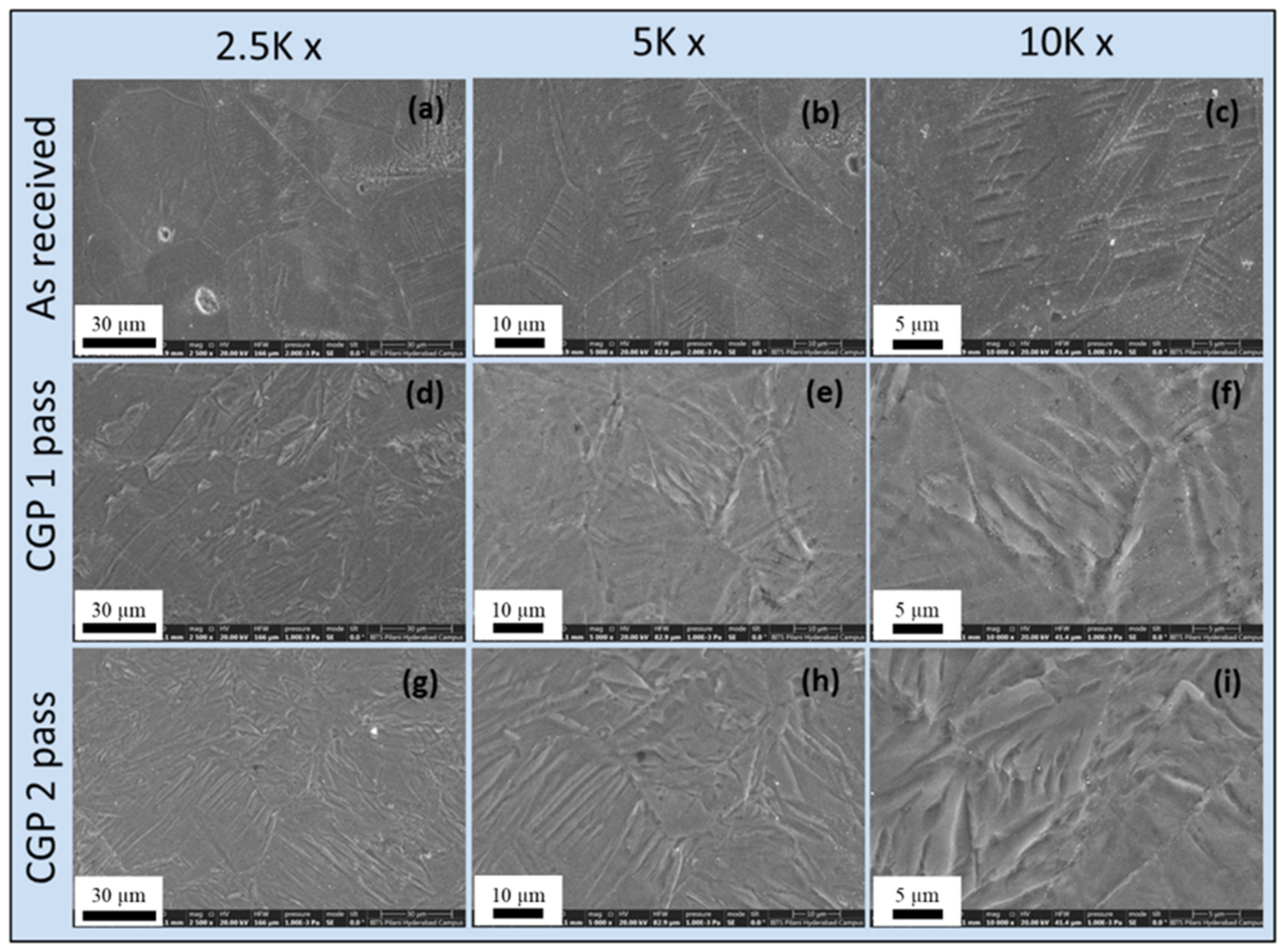

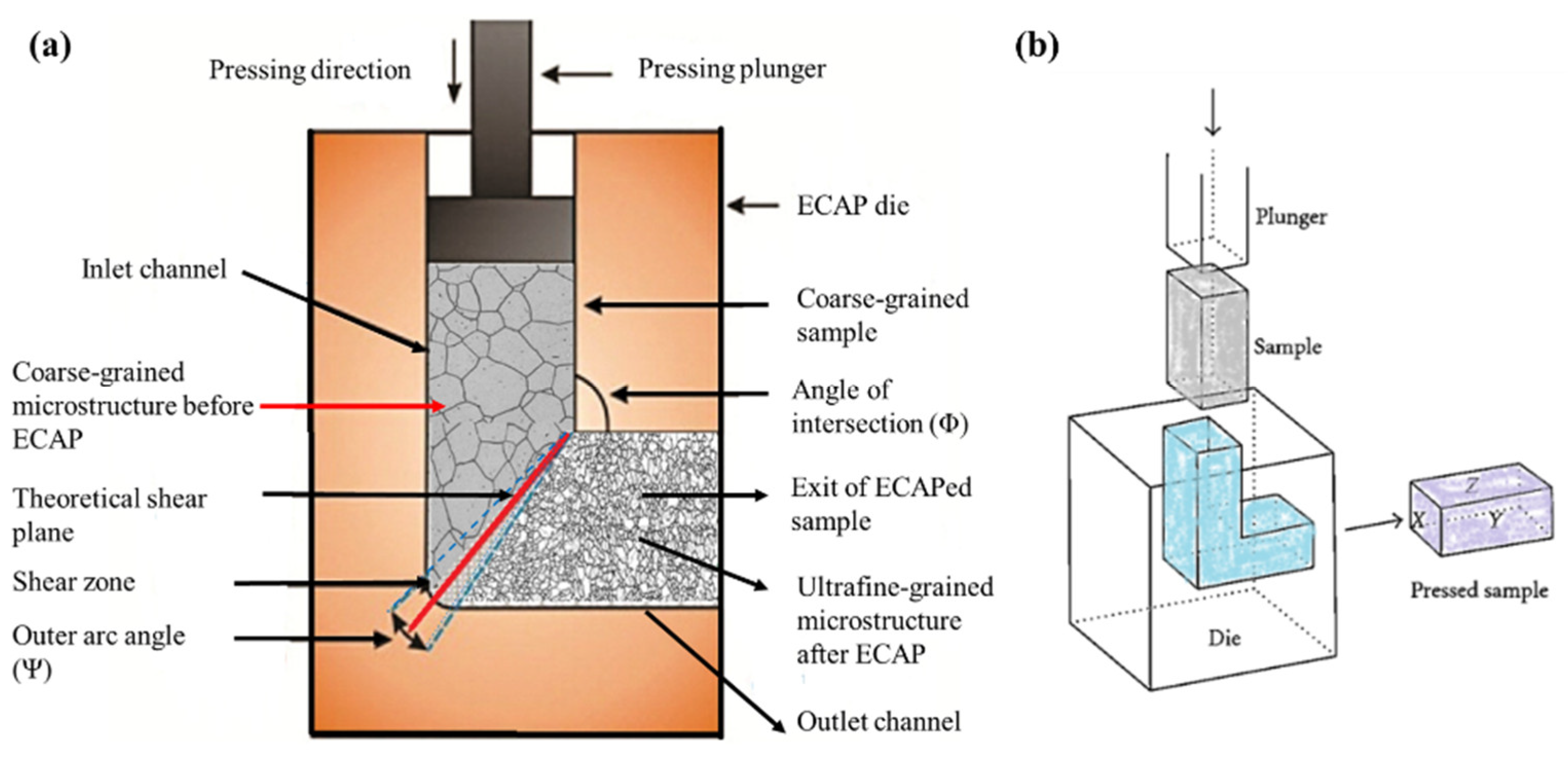
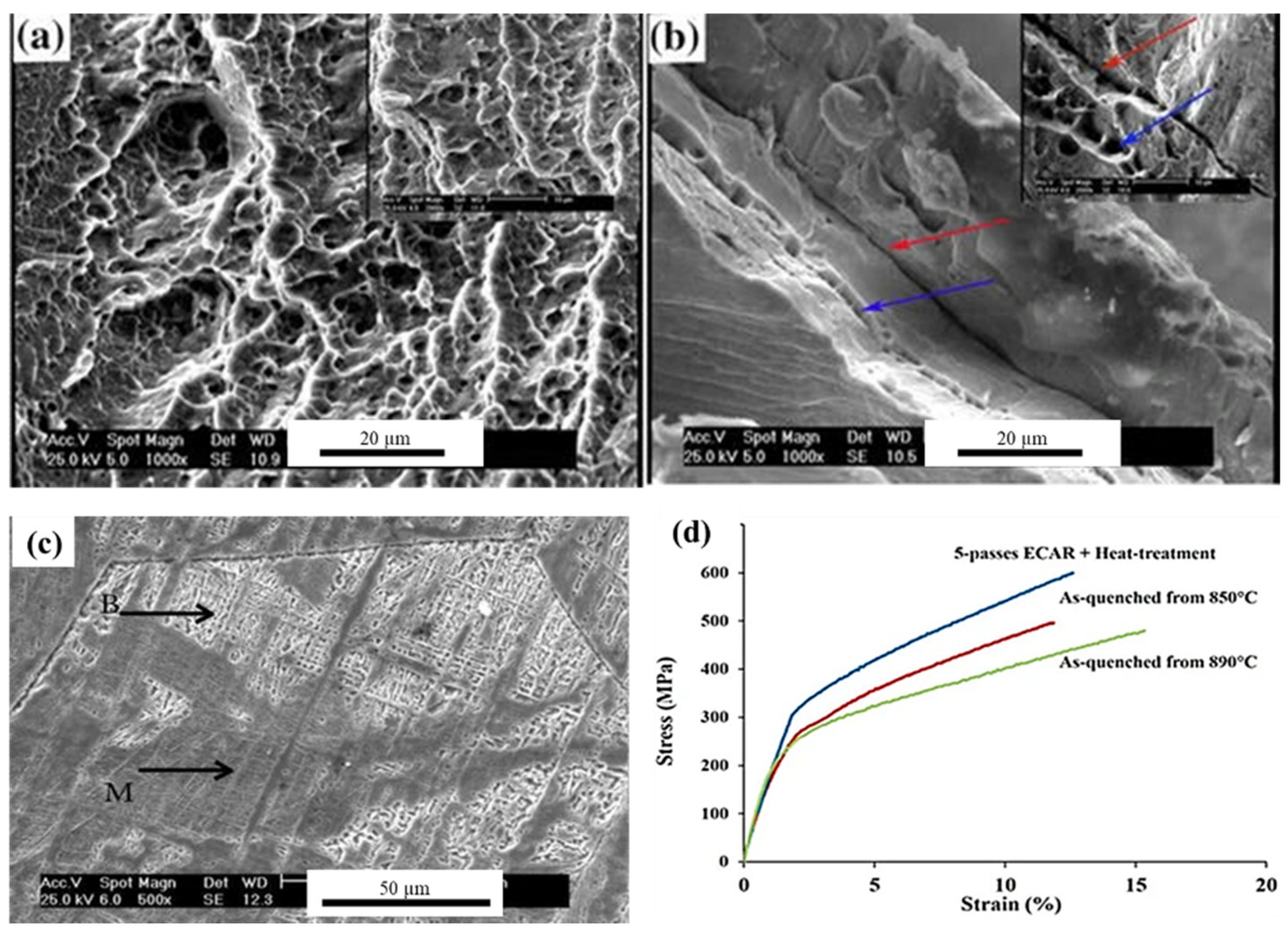
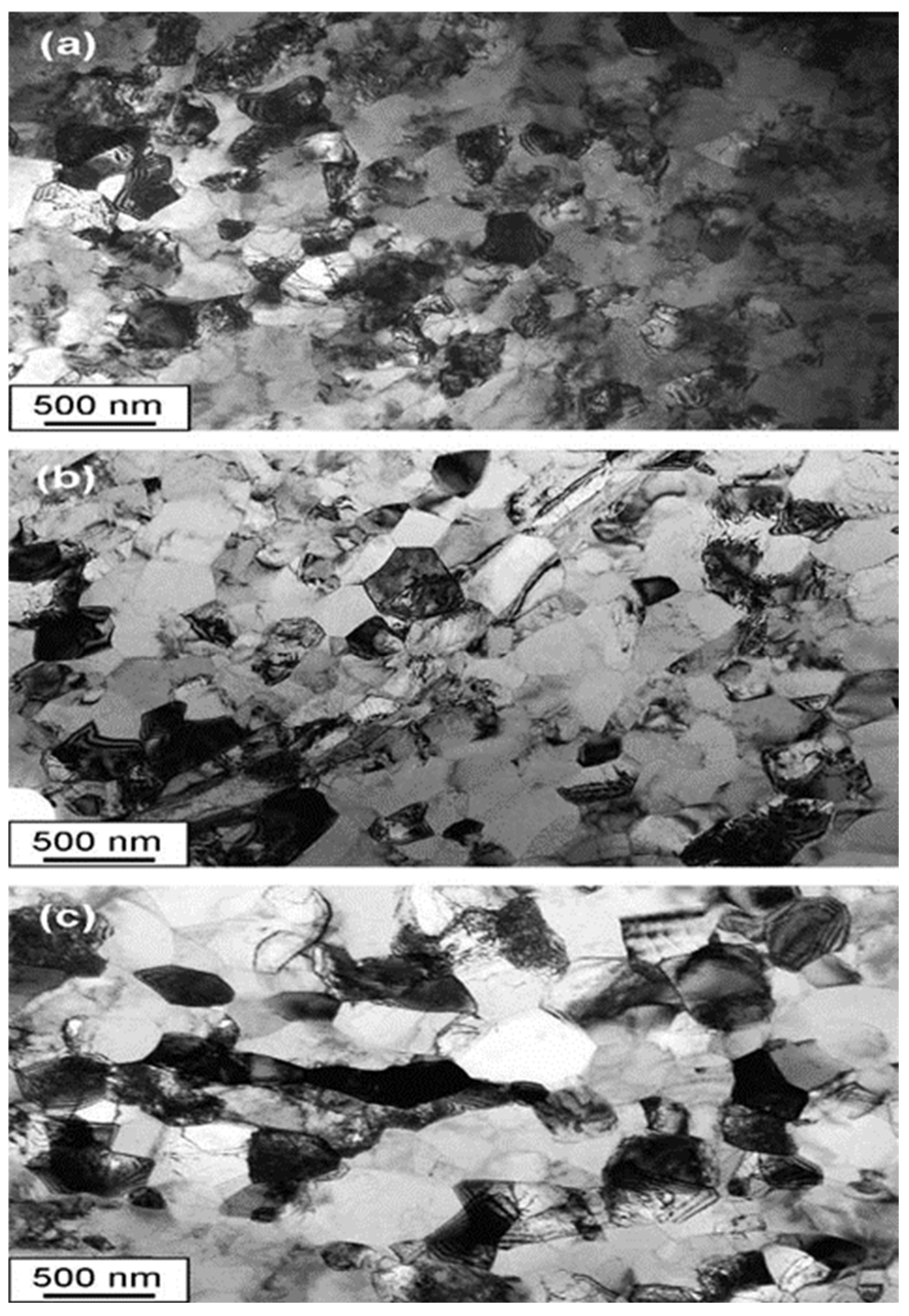
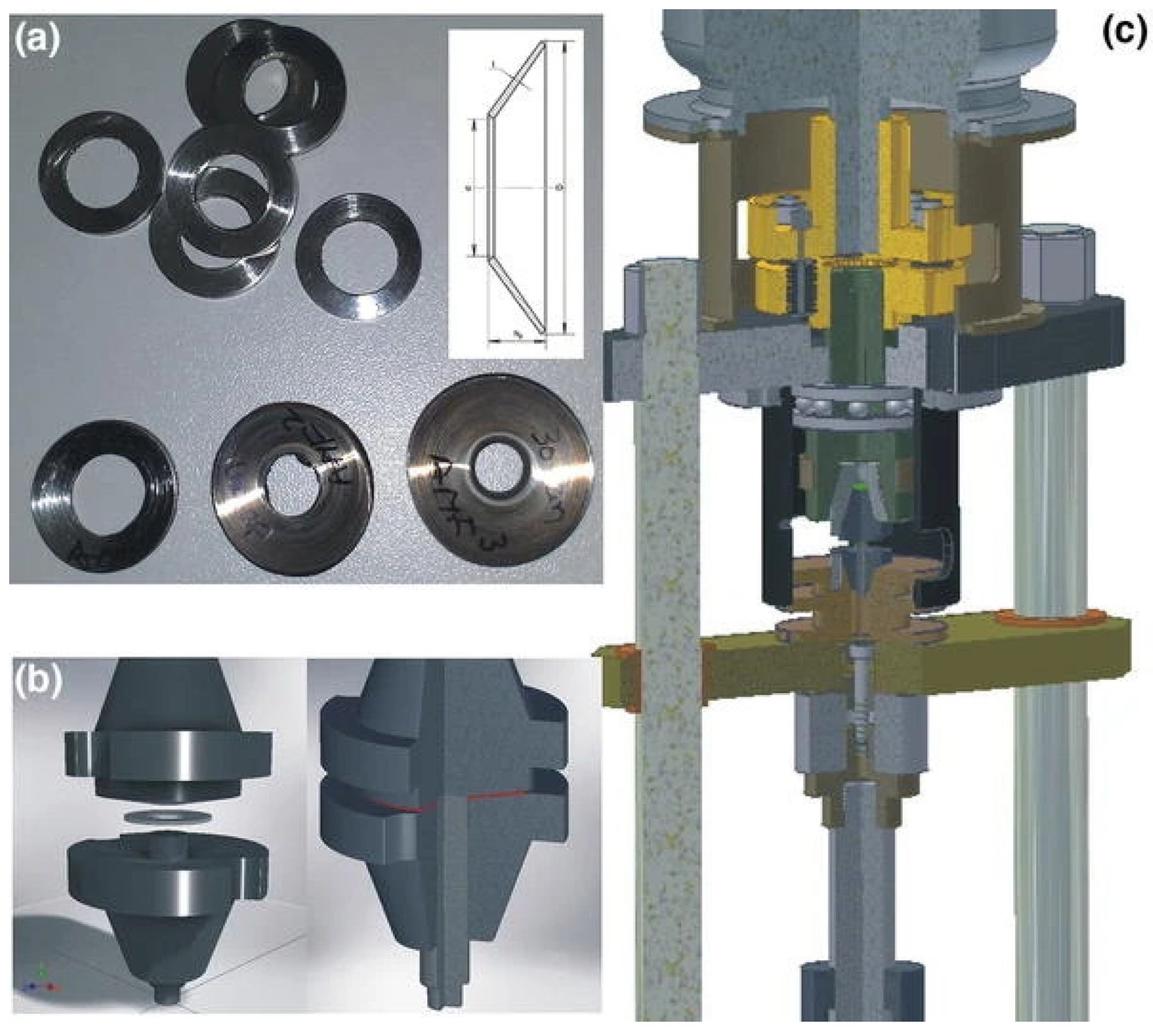
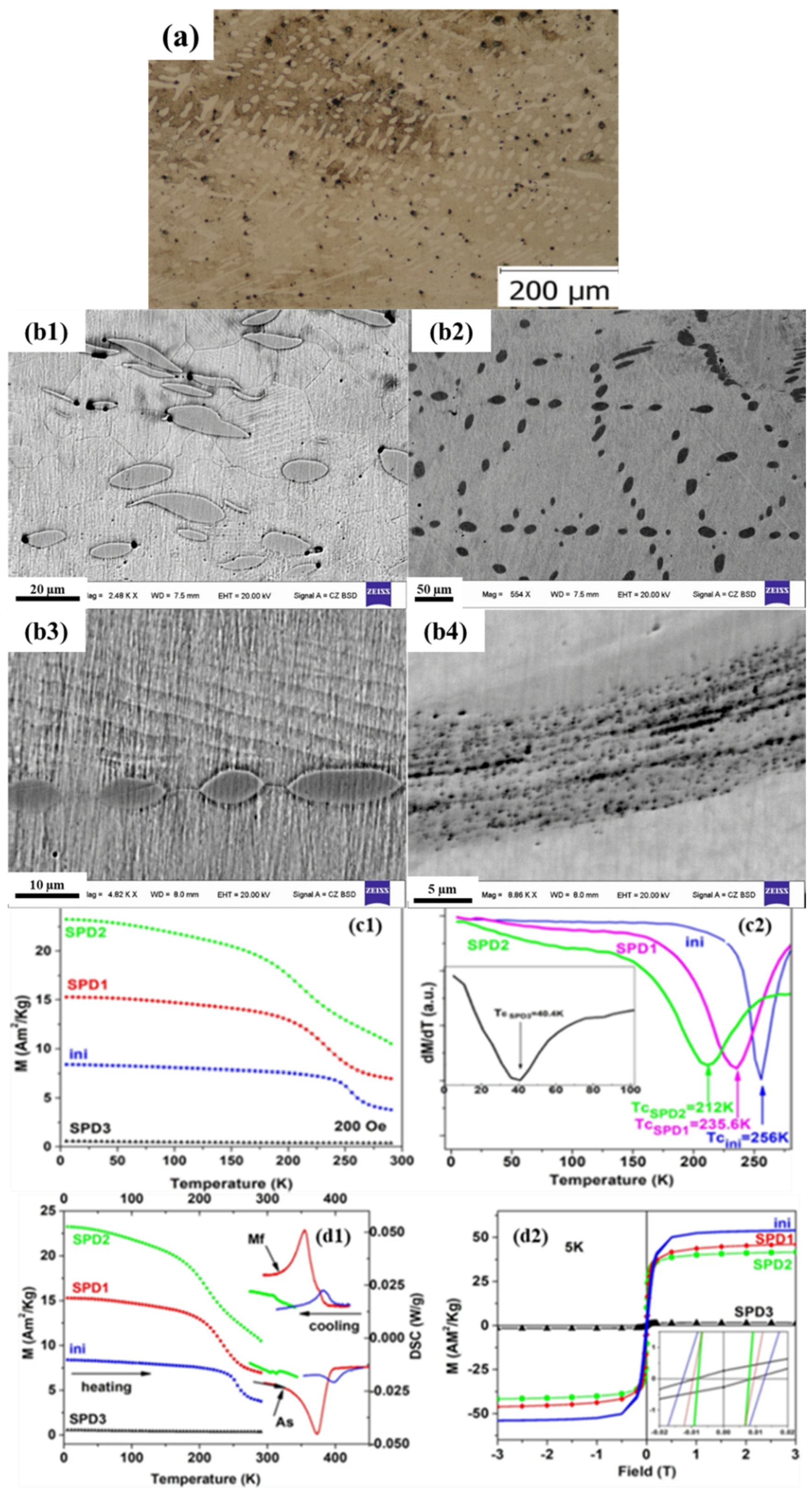


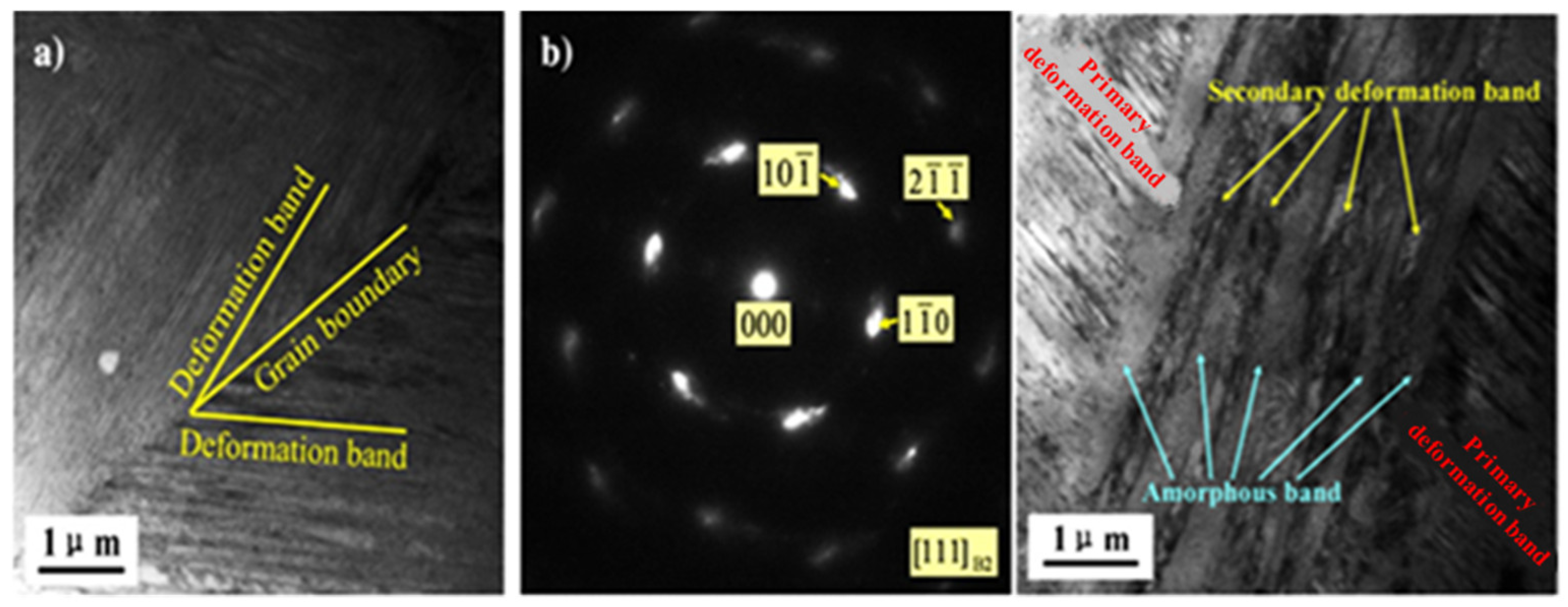



| No. | Type of SMAs | Type of SPD Technique | Application/Feature | Ref. |
|---|---|---|---|---|
| 1 | Ti–Ni | Local canning compression | Amorphous structures | [56] |
| 2 | Ti–Ni | Local canning compression | Effect of the twins on the transformation behavior of the nanocrystalline NiTi | [57] |
| 3 | Ti–Ni | Local canning compression | Mechanisms of amorphization of NiTi SMA | [58] |
| 4 | Ti–Ni | High-pressure torsion | Structural investigations of nanostructured NiTi SMA | [59] |
| 5 | Ti–Ni | Equal-channel angular pressing | Viscoplastic FEM simulation, microstructural observation | [60] |
| 6 | Ti–Ni | High-pressure torsion Equal-channel angular pressing | Phase transformation sequence, microstructural studies | [61] |
| 7 | Ti–Ni | Equal-channel angular pressing | Phase transformation and precipitates’ behavior | [62] |
| 8 | Ti–Ni | Equal-channel angular pressing | Martensitic transformations and effect of second phases | [63] |
| 9 | Ti–Ni | Equal-channel angular pressing | Transformation behavior and effect of pass numbers | [64] |
| 10 | Ti–Ni | Equal-channel angular pressing | Phase transformation, microstructural observation | [65] |
| 11 | Ti–Ni | Equal-channel angular pressing | phase transformations and superelasticity | [66] |
| 12 | Ti50–Ni50, Ti49.5–Ni50.5, Ti50–Ni49–Fe1 | High-speed high-pressure torsion Equal-channel angular pressing | Phase transformation behavior | [67] |
| 13 | Ti–Nb–O | Equal-channel angular pressing | Superelastic behavior and precipitation effects | [68] |
| 14 | Ti–Mo | Equal-channel angular pressing | Martensitic transformations and effect of second phases | [63] |
| 15 | Cu–Al–Be–B | Equal-channel angular pressing | Microstructural observation | [69] |
| 16 | Cu–26Zn–5Al | Accumulative roll-bonding | Shape memory effect and phase distribution | [70] |
| 17 | Cu–Zn–Ni | Accumulative roll-bonding | Martensitic transformation and SMA behavior, microstructural observation | [31] |
| 18 | Cu–Al–Mn | Accumulative roll-bonding | Microstructure, phase formation, corrosion | [71] |
| 19 | Cu–Al–Mn alloys Cu–9.5Al–8.2Mn Cu–8.3Al–8Mn | Accumulative roll-bonding Equal-channel angular rolling | - | [72] |
| 20 | Fe–Mn–Si | High-speed high-pressure torsion | Magnetism | [73] |
| 21 | Fe–Mn–Si | High-speed high-pressure torsion | Actuator | [55] |
| 22 | Ni50.5–Ti49.5 | Constrained groove pressing | Biomedical | [34] |
| 23 | Ni57–Fe18–Ga25 | High-speed high-pressure torsion | Amorphization and magnetism | [74] |
| 24 | Ni50.3–Ti49.7 | High-speed high-pressure torsion | Smart hybrid material | [75] |
| 25 | Ni–Fe–Ga Ni57–Fe18–Ga25 | High-speed high-pressure torsion | Smart hybrid material | [75] |
Disclaimer/Publisher’s Note: The statements, opinions and data contained in all publications are solely those of the individual author(s) and contributor(s) and not of MDPI and/or the editor(s). MDPI and/or the editor(s) disclaim responsibility for any injury to people or property resulting from any ideas, methods, instructions or products referred to in the content. |
© 2023 by the authors. Licensee MDPI, Basel, Switzerland. This article is an open access article distributed under the terms and conditions of the Creative Commons Attribution (CC BY) license (https://creativecommons.org/licenses/by/4.0/).
Share and Cite
Ebrahimi, M.; Attarilar, S.; Gode, C.; Kandavalli, S.R.; Shamsborhan, M.; Wang, Q. Conceptual Analysis on Severe Plastic Deformation Processes of Shape Memory Alloys: Mechanical Properties and Microstructure Characterization. Metals 2023, 13, 447. https://doi.org/10.3390/met13030447
Ebrahimi M, Attarilar S, Gode C, Kandavalli SR, Shamsborhan M, Wang Q. Conceptual Analysis on Severe Plastic Deformation Processes of Shape Memory Alloys: Mechanical Properties and Microstructure Characterization. Metals. 2023; 13(3):447. https://doi.org/10.3390/met13030447
Chicago/Turabian StyleEbrahimi, Mahmoud, Shokouh Attarilar, Ceren Gode, Sumanth Ratna Kandavalli, Mahmoud Shamsborhan, and Qudong Wang. 2023. "Conceptual Analysis on Severe Plastic Deformation Processes of Shape Memory Alloys: Mechanical Properties and Microstructure Characterization" Metals 13, no. 3: 447. https://doi.org/10.3390/met13030447








